Current location: Home > Biological Effects Model > 1° Driver: Exposure > 2° Driver: Occurrence of Sensitive Life Stages |
|
Secondary Driver: Occurrence of Sensitive Life Stages Jump down this page to: Steelhead | Chinook Salmon | Delta Smelt | Longfin Smelt | Sacramento Splittail | White Sturgeon | Green Sturgeon | Striped Bass An individual fish’s exposure to low DO concentration results from the interaction of its ecology and behavior and ambient forces that determine local concentrations of DO. The timing of fish movements through areas is determined by migration and movement patterns that are species- and often population-specific. The following figure shows the species of fish that may occur in the DWSC during the year and when they occur, together with monthly summaries of DO and water temperature. 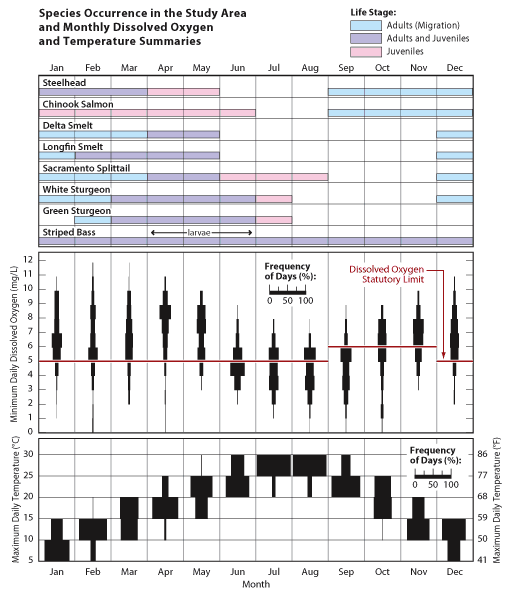
June through October are the months with the lowest DO concentrations, with concentrations falling below 5 mg/L. Juvenile fish of the following species all occur in some or all of these months: fall-run Chinook salmon, white sturgeon, striped bass, Sacramento splittail, and American shad. Adult fish, such as fall-run Chinook salmon, steelhead, and delta smelt occur from September to October. During the winter months and early spring (November through April), when precipitation begins and flows increase as a result of snowmelt, DO concentrations rise above 5 mg/L for most days. However, historically, releases from the City of Stockton Regional Wastewater Control Facility have caused some episodes of low DO concentrations in the DWSC during the winter. These episodes are not expected to occur in the future because improvements are being made to the facility. Adult Chinook salmon continue their upstream migration through January, and steelhead continue migrating through March. Juvenile steelhead and Chinook salmon also migrate downstream when flows are high, typically January through May. Outmigration of juvenile white sturgeon, splittail, and delta smelt also occurs during these months. Jump to "General Effects" discussion under other Secondary Drivers: Steelhead (Oncorhynchus mykiss) Hypothesis: Central Valley steelhead are exposed to DO concentrations below the regulatory minimum in the DWSC during periods when adults migrate through the Delta to upstream spawning areas and juveniles migrate to downstream rearing areas in the estuary and ocean. 1. How does this driver operate? The following figure illustrates the primary periods of occurrence of steelhead juveniles and adults in the Stockton DWSC in relation to minimum DO concentrations and maximum water temperatures. 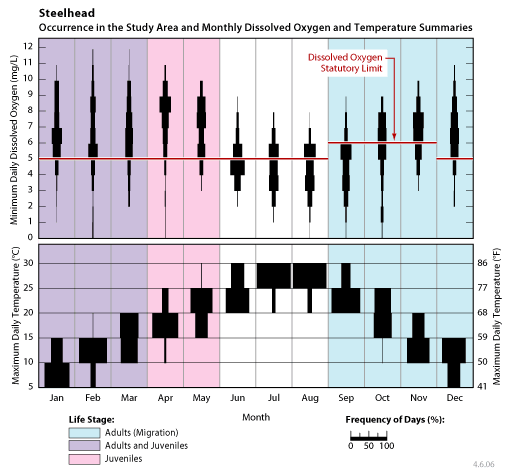
Adult steelhead migrate upstream through the Delta and into the Sacramento and San Joaquin River system to spawn in late fall to spring. Juveniles migrate downstream in the late winter to early spring after rearing in natal streams for 1 to 2 years. While evidence of significant spawning runs is lacking, there is evidence that steelhead occur in the San Joaquin River system.
2. Are there critical thresholds associated with this driver? N/A 3. How important is this driver? Migration timing determines the extent to which adult and juvenile steelhead would be subjected to low DO concentrations in the DWSC. Because adults, juveniles, and smolts migrate through the Delta mostly in the late fall to early spring when DO concentrations frequently exceed the regulatory minimum, low DO concentrations in the DWSC are not likely to have a significant effect on steelhead populations in the San Joaquin River drainage. 4. How well is this driver understood? The general migration timing of Central Valley steelhead is known, but the migratory pathways and numbers of adult and juvenile steelhead using the DWSC are uncertain. Jump to "Steelhead" discussion under other Secondary Drivers: Chinook Salmon (Oncorhynchus tshawytscha) Hypothesis: Central Valley fall-/late fall–run Chinook salmon are exposed to DO concentrations below the regulatory minimum in the DWSC when adults migrate to upstream spawning areas in the San Joaquin River drainage and juveniles migrate to downstream rearing areas in the Delta and Pacific Ocean. 1. How does this driver operate? The following figure illustrates the primary periods of occurrence of fall-run Chinook salmon juveniles and adults in the Stockton DWSC in relation to minimum DO concentrations and maximum water temperatures. 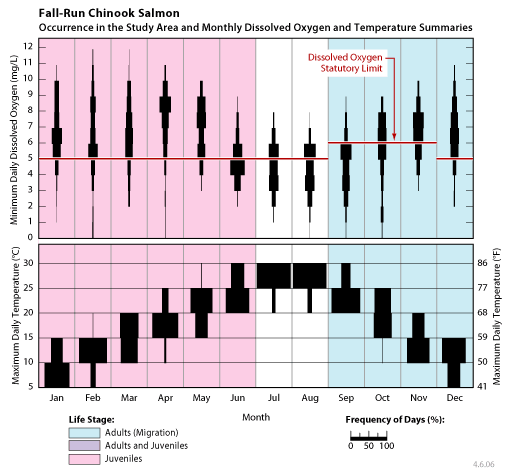
Currently, only Central Valley fall-run and late fall–run Chinook salmon spawn in the San Joaquin River and its tributaries, the Merced, Tuolumne, and Stanislaus Rivers (Baker and Morhardt 2001). Historically, spring-run Chinook salmon occurred in the San Joaquin River but have since been extirpated. The Central Valley spring run occurs only in the Sacramento River drainage, and the Sacramento River winter-run Chinook salmon is found only in the upper Sacramento River below Keswick Dam (Moyle 2002). However, juveniles of all runs (fall, late fall, winter, and spring) occur in the Delta (Brandes and McLain 2001). Central Valley fall- and late fall–run Chinook salmon may be exposed to DO concentrations below the regulatory minimum in the DWSC when adults migrate through the Delta on their way to freshwater spawning areas (August through January) and juveniles migrate through the Delta on their way to estuarine and marine rearing areas (January through June). The potential for exposure of Chinook salmon to low DO concentrations in the DWSC is highest from August through October when adults are migrating through the Delta to upstream spawning areas. 2. Are there critical thresholds associated with this driver? N/A 3. How important is this driver? Migration timing is important because it determines the extent to which adult and juvenile Chinook salmon could be exposed to low DO concentrations in the DWSC. Adults are at higher risk of exposure to low DO concentrations than juveniles because the primary migration for adult fall-run Chinook salmon begins in August and September when DO concentrations below the regulatory minimum are most prevalent in the DWSC. 4. How well is this driver understood? The migration timing of adult Chinook salmon in the lower San Joaquin River is well documented (Hallock et al. 1970; Resources Agency of California 1964; Mesick 2001). Jump to "Chinook Salmon" discussion under other Secondary Drivers: Delta Smelt (Hypomesus transpacificus) Hypothesis: On their way to and from spawning grounds located farther up the San Joaquin River, some delta smelt migrate through the DWSC during periods when DO concentrations in the ship channel are below the regulatory minimum. 1. How does this driver operate? The following figure illustrates the primary periods of occurrence of Delta smelt larvae, juveniles, and adults in the Stockton DWSC in relation to minimum DO concentrations and maximum water temperatures. 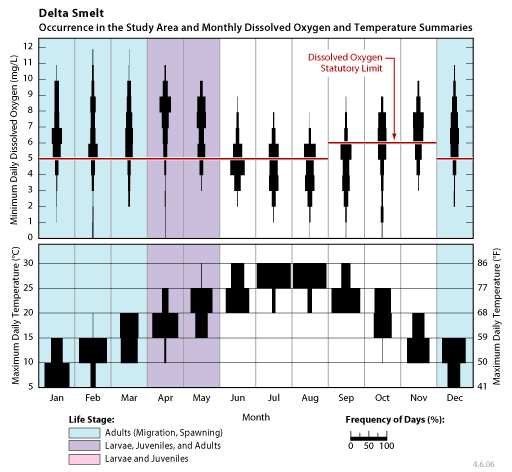
Delta smelt may be exposed to DO concentrations below the regulatory minimum in the DWSC as:
The presence of low DO concentrations in the DWSC may restrict or prevent the movement of delta smelt migrating to and from spawning habitats. Low DO concentrations probably do not affect:
2. Are there critical thresholds associated with this driver? N/A 3. How important is this driver? The spatial and temporal patterns of distribution of different life stages are extremely important because they determine both the potential for exposure to low DO concentrations in the DWSC and the susceptibility to low DO concentrations (because fish in different life stages likely differ in their requirements for DO). 4. How well is this driver understood? This driver is not well understood because it is not known how low DO concentrations affect the migration of delta smelt. The exact nature and extent of spawning habitat and how they affect delta smelt migrating to and from spawning habitat are still unknown (Moyle 2002; Bennett 2005); thus, the location, frequency, and extent of delta smelt spawning upstream of the DWSC are unclear. DFG’s Fall Mid-Water Trawl survey (which detects only the later life stages of delta smelt) has caught delta smelt in the southeastern Delta in every month that the survey operates (September through March) and at sites in the DWSC between November and March (California Department of Fish and Game, unpublished data). Delta smelt are believed to spawn in fresh water, and adults are known to occur at least as far south as Mossdale, more than 10 miles upstream of Stockton on the San Joaquin River (Moyle 2002; Swanson pers. comm.). Thus, delta smelt probably use habitat upstream of the DWSC for spawning (Moyle 2002; Swanson pers. comm.). Jump to "Delta Smelt" discussion under other Secondary Drivers: Longfin Smelt (Spirinchus thaleichthys) Hypothesis: Longfin smelt do not use the DWSC in appreciable numbers for foraging, rearing, or migrating to or from their spawning grounds. 1. How does this driver operate? The following figure illustrates the primary periods of occurrence of longfin smelt larvae, juveniles, and adults in the Stockton DWSC in relation to minimum DO concentrations and maximum water temperatures. 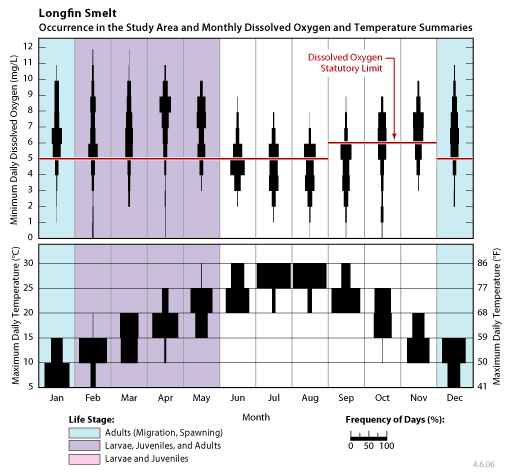
Longfin smelt may be exposed to DO concentrations in the DWSC that are lower than the regulatory minimum as adults migrate to freshwater spawning areas (late fall through late winter) in the San Joaquin River and as larvae and young juveniles migrate downstream in the San Joaquin River toward the saline part of the Delta soon after hatching. The exact nature and extent of spawning habitat are still unknown for this species (Moyle 2002), although major aggregations of gravid adults occur in the northwestern Delta and eastern Suisun Bay (Rosenfield and Baxter, pers. comm.). Longfin smelt are not detected frequently in or near the DWSC. Most juvenile longfin smelt are found in brackish waters west of the Delta. Prespawning adults are generally restricted to brackish (2–35 ppt) or marine habitats. 2. Are there critical thresholds associated with this driver? Spawning migrations are diffuse and appear to occur throughout the winter. No triggers/thresholds that release spawning activity have been documented. 3. How important is this driver? The spatial and temporal patterns of distribution of different life stages are extremely important because they determine both the potential for exposure to low DO concentrations in the DWSC and the susceptibility to adverse effects from low DO concentrations (because fish in different life stages likely differ in their requirements for DO). 4. How well is this driver understood? Little is known about the location or frequency of longfin smelt spawning upstream of the DWSC. Longfin smelt in this estuary spawn in fresh or slightly brackish water (other populations outside of this estuary spawn in fresh water) (Chigbu and Sibley 1994). Prior to spawning, these fish aggregate in deepwater habitats available in the northern Delta, including primarily the channel habitats of Suisun Bay and the Sacramento River (Rosenfield and Baxter, pers. comm.). Moyle (2002) indicated that longfin smelt may spawn in the San Joaquin River as far upstream as Medford Island. Two sampling programs operated by the DFG during the spawning season—the Fall Mid-Water Trawl and the Bay Study—detected very few adult longfin smelt in the San Joaquin channel. Wang (1991) detected larval and juvenile longfin smelt in the lower San Joaquin channel during 1989 and 1990, but it is not clear whether these juveniles hatched upstream in the San Joaquin River or migrated across the Delta from a spawning site in the Sacramento River. Most of the juveniles detected by Wang (1991) were caught in the lower Sacramento River and Suisun Bay, not the San Joaquin River. There is no evidence that postlarval, prespawning longfin smelt make use of habitat in or above the DWSC. Jump to "Longfin Smelt" discussion under other Secondary Drivers: Sacramento Splittail (Pogonichthys macrolepidotus) Hypothesis: On their way to and from spawning grounds located farther up the San Joaquin River, some Sacramento splittail migrate through the DWSC during periods when DO in the channel is below the regulatory minimum. 1. How does this driver operate? The following figure illustrates the primary periods of occurrence of Sacramento splittail larvae, juveniles, and adults in the Stockton DWSC in relation to minimum DO concentrations and maximum water temperatures. 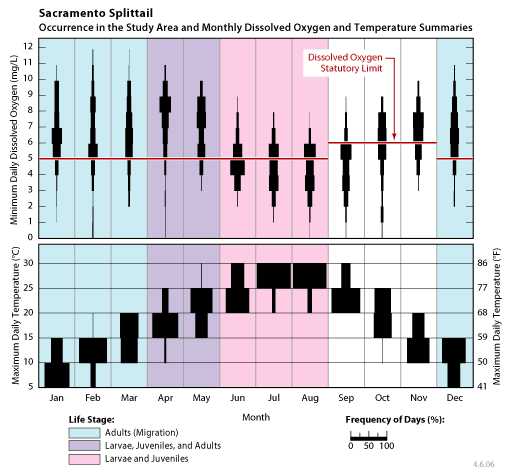
Sacramento splittail may be exposed to DO concentrations below the regulatory minimum in the DWSC during periods when:
In the San Joaquin drainage during recent wet years, spawning has been recorded as far upstream as the Tuolumne River (Moyle 2002). The presence of low DO concentrations in the DWSC may restrict or prevent the movement of Sacramento splittail migrating to and from spawning habitat in the San Joaquin basin. Low DO concentrations probably do not affect:
2. Are there critical thresholds associated with this driver? Sacramento splittail spawning migrations occur over a long, poorly defined period throughout the winter. The environmental and biological factors that trigger spawning migrations are not well understood but are believed to include increased freshwater flows (Moyle et al. 2004). 3. How important is this driver? The spatial and temporal patterns of distribution of different life stages are extremely important because they determine both the potential for exposure to low DO concentrations in the DWSC and the susceptibility to adverse effects of low DO concentrations (because fish in different life stages likely differ in their requirements for DO). 4. How well is this driver understood? Sacramento splittail use of habitats in the San Joaquin River, upstream of the DWSC, is well documented (Moyle 2002; Moyle et al. 2004). The presence of Sacramento splittail in the DWSC during periods of low DO concentrations has not been documented. Both the upstream and downstream spawning migrations of this species are diffuse and occur mainly during periods of high flow, when low-DO episodes are less likely to occur. How frequently and to what extent Sacramento splittail encounter low DO concentrations in the DWSC are unknown. Jump to "Sacramento Splittail" discussion under other Secondary Drivers: White Sturgeon (Acipenser transmontanus) Hypothesis: Some white sturgeon migrate through the DWSC, on their way to and from spawning grounds located farther up the San Joaquin River, during periods when DO in the DWSC is below the regulatory minimum. 1. How does this driver operate? The following figure illustrates the primary periods of occurrence of white sturgeon larvae, juveniles, and adults in the Stockton DWSC in relation to minimum DO concentrations and maximum water temperatures. 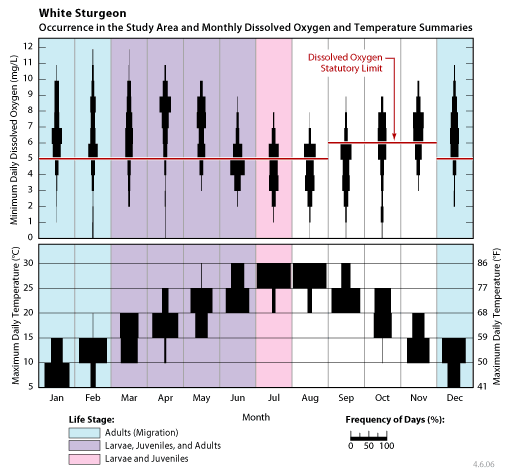
White sturgeon may be exposed to DO concentrations lower than the regulatory minimum in the DWSC as adults migrate to freshwater spawning areas (winter through spring) and larvae and young juveniles migrate into the lower parts of the Delta from early spring through mid-summer (Schaffter 1997). Adults spawn in fresh water, presumably in deep, fast currents of major rivers (Moyle 2002); thus, spawning within the DWSC is unlikely. Moyle (2002) indicated that white sturgeon may spawn in the San Joaquin River. Given their habitat selection in the Sacramento River, if white sturgeon spawn in the San Joaquin River, it is likely that they spawn in deep, fast-flowing sections of river upstream of the DWSC. Spawning migrations appear to be triggered by high flows associated with runoff from winter storms and spring snowmelt (Schaffter 1997; Moyle 2002). Downstream migrations may also be triggered by high-flow events, although downstream migrations are not well studied. Most of the white sturgeon life cycle is spent in the lower portions of the estuary and the Pacific Ocean. As a result, fish spawned upstream in the San Joaquin River must pass through the DWSC on their way to rearing habitats. 2. Are there critical thresholds associated with this driver? N/A 3. How important is this driver? The spatial and temporal patterns of distribution of different life stages are extremely important because they determine the potential for exposure to low DO concentrations in the DWSC and the susceptibility of the population to adverse effects from low DO concentrations (because fish in different life stages likely differ in their requirements for DO). 4. How well is this driver understood? The location, frequency, and extent of white sturgeon spawning upstream of the DWSC are unknown. Spawning in the Sacramento River, and occasionally in the Feather River, is well documented (Moyle 2002). Because of the general historical similarities (size, seasonality of flows) of the San Joaquin and the Sacramento Rivers, it is believed that white sturgeon may have used and may still use the San Joaquin (and potentially some of its tributaries) for spawning (Moyle 2002), although there is little direct evidence of this. Jump to "White Sturgeon" discussion under other Secondary Drivers: Green Sturgeon (Acipenser medirostris) Hypothesis: Green sturgeon do not use the DWSC in appreciable numbers for foraging, rearing, or migrating to or from their spawning grounds. 1. How does this driver operate? The following figure illustrates the primary periods of occurrence of green sturgeon larvae, juveniles, and adults in the Stockton DWSC in relation to minimum DO concentrations and maximum water temperatures. 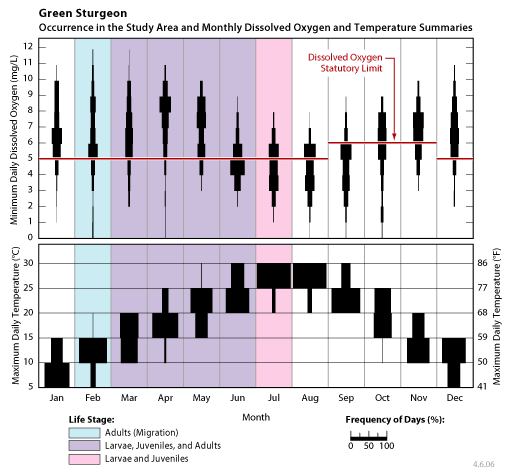
There is no information indicating that green sturgeon use habitats in the San Joaquin River drainage for spawning or rearing. Also, there are no data that suggest these fish use the DWSC for foraging, rearing, or any other part of their life cycle. Given the current state of knowledge, it seems unlikely that low DO concentrations in the DWSC have a predictable or significant impact on green sturgeon population in the Delta. 2. Are there critical thresholds associated with this driver? N/A 3. How important is this driver? The spatial and temporal patterns of distribution of different life stages are extremely important because they determine both the potential for exposure to low DO concentrations in the DWSC and the susceptibility to low DO concentrations (because fish in different life stages likely differ in their requirements for DO). 4. How well is this driver understood? Information about green sturgeon in the Delta is generally limited; for example, just over two dozen of these fish were caught in DFG’s Fall Mid-Water Trawl from 1967 to 2004. On the other hand, there is no reason to believe that green sturgeon did not use the San Joaquin River or its tributaries prior to human modification of those waterways (such as the DWSC itself). NOAA Fisheries made this point in their recent Endangered Species Act listing decision for green sturgeon (70 FR 17386-17401; April 6, 2005):
As research produces more information about green sturgeon in the Delta, it may become clear that they do use habitats in and around the DWSC and that they are affected by low DO concentrations in the DWSC. Thus, the structure for a description of green sturgeon’s reaction to low DO has been retained in this conceptual model so that information can be input as it is developed. Jump to "Green Sturgeon" discussion under other Secondary Drivers: Striped Bass (Morone saxatilis) Hypothesis: Striped bass migrate through the DWSC to and from spawning grounds in the upper San Joaquin River. DO concentrations near or below the statutory minimum may affect only juvenile striped bass. 1. How does this driver operate? The following figure illustrates the primary periods of occurrence of striped bass larvae, juveniles, and adults in the Stockton DWSC in relation to minimum DO concentrations and maximum water temperatures. 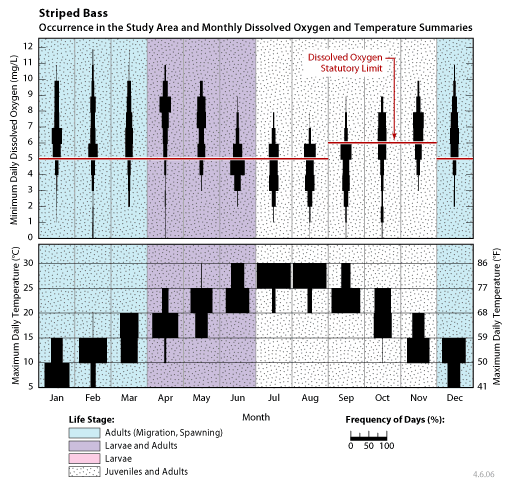
Striped bass may be exposed to DO concentrations lower than the regulatory minimum in the DWSC when adults migrate to spawning areas upstream of the DWSC and juveniles migrate downstream to rearing areas in the Delta and estuary. Low DO concentrations are not likely to prevent adult striped bass from migrating through the DWSC for several reasons.
Low DO concentrations are more likely to have a significant effect on larval and juvenile striped bass.
2. Are there critical thresholds associated with this driver? The occurrence of adult striped bass in the DWSC (and subsequently juveniles, as a result of spawning) is probably closely related to flow thresholds. Recent studies suggest striped bass migrate through the DWSC on their way to spawning grounds only during wet years, when river flows are high enough to dilute saline agricultural return waters in the San Joaquin River (Turner and Chadwick 1972; Moyle 2002; California Department of Fish and Game 2005). The annual patterns of migration through the DWSC and the frequency of spawning in the San Joaquin River are unknown. 3. How important is this driver? This driver may not have an important influence on striped bass population dynamics. While conditions in the DWSC may adversely affect larval and juvenile striped bass, migrating and spawning adults are not likely to be affected by typical DO concentrations during this spring migration. The relative contribution of striped bass spawning in the San Joaquin River system to overall abundance in the Central Valley is unknown. Most recruitment is thought to come from spawning in the Sacramento River and from the San Joaquin River below the DWSC. Lastly, adult striped bass are likely to enter the DWSC only during wet years when the frequency and severity of low-DO events are reduced compared to normal and dry years.. 4. How well is this driver understood? Understanding of the potential exposure of striped bass to low DO concentrations in the DWSC is limited because the only information available is raw catch data and general life history accounts of striped bass in San Francisco Bay (Turner and Chadwick 1972; Stevens et al. 1985; California Department of Fish and Game 2005). Although no formal analysis is available, historical data on striped bass presence and size distribution for the DWSC are available from DFG (through the BDAT database, http://bdat.ca.gov/). These data, which are a combination of trawl and townet data from 1959 through 2004, suggest that:
Jump to "Striped Bass" discussion under other Secondary Drivers: |